The Effectiveness of Influencer Marketing in Promoting Sustainable Lifestyles and Consumer Behaviours
Sritha Vemuri*  , Jahnavi P
, Jahnavi P  , Lingala Manasa
, Lingala Manasa  and Pallavi D. R.
and Pallavi D. R. 
1CMS-JAIN (Deemed-to-be University), Bangalore, Karnataka India .
Corresponding author Email: sritha_vemuri2021@cms.ac.in
DOI: http://dx.doi.org/10.12944/JBSFM.05.02.05
Influencer marketing is a kind of marketing across social media platforms involving endorsements, recommendations, support, and product placement from influencers. Influencers are usually people online that have a large following on social media and use this identity to influence the opinions and behaviours of their audience. Influencer marketing is a powerful tool to reach the people in this generation, and that can also be used to promote sustainable lifestyles and consumer behaviour. Influencers have the potential and effectiveness to alter consumer mindsets. When influencers promote sustainable products and practices, they can reach a large audience and positively impact the environment. Although the effectiveness of influencer marketing depends on some factors including the credibility and trustworthiness of the influencer, the content of the message given by them, and the target audience, the impact nevertheless is huge. This study uses a survey questionnaire to gather data on 200 consumers in India. The primary responses were collected all over India using a structured questionnaire consisting of questions to understand consumer behaviour, sustainability, and the role of an influencer marketer. It examines influencer marketing exposure, purchase behaviour, and brand perception. The review of literature for this topic focuses on the impact of influencer marketing on sustainable lifestyles and consumer behaviour between 2000-2023. There are certain challenges and ethical implications concerning influencer marketing that are explored in the paper, along with people responses and acceptability towards a sustainable lifestyle. The empirical study also focused on the effectiveness of influencer marketing in promoting sustainable lifestyles and consumer behaviours. Influencer marketing can be a valuable tool for promoting sustainable lifestyles and consumer behaviour in this generation. Incorporating influencer marketing as a tool has two faces and it is essential to understand both aspects.
Copy the following to cite this article:
Vemuri S, Jahnavi P, Manasa L, Pallavi D. R. "The Effectiveness of Influencer Marketing in Promoting Sustainable Lifestyles and Consumer Behaviours". Journal of Business Strategy Finance and Management, 5(2). DOI:http://dx.doi.org/10.12944/JBSFM.05.02.05
Copy the following to cite this URL:
Vemuri S, Jahnavi P, Manasa L, Pallavi D. R. "The Effectiveness of Influencer Marketing in Promoting Sustainable Lifestyles and Consumer Behaviours". Journal of Business Strategy Finance and Management, 5(2). Available here:https://bit.ly/3Ny35Ww
Download article (pdf) Citation Manager Publish History
Select type of program for download
| Endnote EndNote format (Mac & Win) | |
| Reference Manager Ris format (Win only) | |
| Procite Ris format (Win only) | |
| Medlars Format | |
| RefWorks Format RefWorks format (Mac & Win) | |
| BibTex Format BibTex format (Mac & Win) |
Article Publishing History
| Received: | 14-11-2023 |
|---|---|
| Accepted: | 14-12-2023 |
| Reviewed by: | 
 Mohammad Rakibul Islam Bhuiyan
Mohammad Rakibul Islam Bhuiyan |
| Second Review by: |

 Sarthak Sengupta
Sarthak Sengupta |
| Final Approval by: | Dr. Manisha Pal |
Introduction
Statement of problem: Although influencer marketing has been acknowledged for its ability to support sustainability and impact consumer decisions, a thorough knowledge of its efficacy in generating observable behavioral shifts and long-term sustainable behaviors is still lacking. The current study challenge centers on the necessity of investigating and examining the particular tactics, categories of material, and ways of interaction that influencers use to effectively promote sustainable lifestyles. Closing this gap will help with the development of more focused and effective tactics as well as insights into how to optimize influencer marketing campaigns for sustainability.
In recent years, the world has witnessed a significant shift in consumer preferences with an increasing emphasis on sustainable living and environmentally conscious choices which is supported by the effect of being influenced by what people are seeing online. The world is challenged with certain ecological issues, which include climate change, global warming, and resource depletion, and hence consumers are getting more conscious about what products they buy. This has given rise to a powerful force in the marketing landscape - influencer marketing. The term influencer marketing is of recent origin but of great significance. Influencer marketing is a form of marketing that happens on social media platforms that involves endorsing products or brands by influencers who are people or organizations who either have a high level of knowledge or who have social influence in the field. They can be small celebrities who gained fame from online platforms like Instagram, YouTube, TikTok, and more. These influencers have a massive effect on persuading their audience.
In this digital age, social media influencers wield considerable influence over their followers' decisions, and this is interconnected to the pattern of sustainable lifestyles and consumer behaviour. There is no better tool than this to bridge the gap between brands and consumers.
This is a new communication model. Consumers’ increasing doubtfulness and mistrust toward traditional marketing has made it much simpler and has paved the way for influencer marketing. Many companies, firms, or brands turn to influencers to promote their offerings. "Consumers are increasingly looking to influencers for guidance and inspiration on living sustainably, creating a significant opportunity for brands." (Audrezet et al., 2023)
The effectiveness of influencer marketing in pushing sustainable lifestyles and influencing consumer behaviour is something that can be studied.
Sustainable living refers to a lifestyle that involves reducing the use of Earth's natural resources by simultaneously aiming to reduce the person's carbon footprint by doing activities that are eco-friendly or sustainable. This lifestyle is being opted for by a lot of people in this generation and is also being promoted widely online. There are various sustainable goals that different companies try to achieve. And this can be done and supported with the help of influencer marketing. For example, let us consider the fashion brand Zara. They have come up with multiple plans and initiatives to become much more sustainable by cutting emissions and using low-impact fibers. Awareness about this can reach far and wide with the help of the internet, more specifically influencer marketing. As an audience, we tend to listen, follow, and practice what we hear from influencers and in turn support the company and its goals. This affects consumer behaviours and buying patterns.
Social media influencers, individuals with substantial online followings and the ability to engage their audience, have become fundamental in shaping consumer perceptions and driving purchasing decisions. As sustainability becomes an essential element in consumer decision-making, influencers have identified this and used it to their advantage as well as promote eco-friendly choices. Influencers play a critical role in framing sustainability narratives that align with their followers. The authentic and relatable content posted online allows them to create an emotional connection with their audience, creating a sense of trust and credibility that traditional advertising often lacks. This shows the persuasive nature of marketing in general.
Audience engagement is what companies look for these days in their attempt to market themselves.
“The importance of consumerism for business survival and growth albeit in a more authentic, meaningful, and sustainable way along with the increasing use of digital media such as social media have led to the proliferation of social media influencer marketing and its burgeoning interest among academics and professionals.” (Joshi et al., 2023).
Influencers can create interactive campaigns and challenges that allow action that encourages their followers to participate actively in sustainable initiatives. By making sustainability accessible and engaging, influencers inspire their audience to adopt greener behaviours, thereby cultivating a positive impact on the environment. Influencers not only support sustainable products but also drive shifts in consumer behaviour. This is what impacts the company. This shift in people is the aspect that is being influenced and what in turn drives business.
Influencer marketing, particularly in terms of sustainability has the following advantages
Cost-effective - Influencer marketing is usually more economical than advertising strategies followed previously, making it an attractive option for sustainability-focused campaigns, especially for smaller brands with limited budgets.
Credibility and authenticity - Influencers often build relationships with their followers based on authenticity, creating a powerful trust that can be harnessed to promote sustainable lifestyles genuinely. There is a great deal of originality in their content.
Research Gap: There is still a knowledge vacuum regarding the precise mechanisms and variables that boost influencer marketing's efficacy when it comes to sustainability, despite the growing recognition of its role in encouraging sustainable lifestyles and influencing consumer behaviors. More specialized studies are required to determine how influencers might effectively explain and promote sustainable behaviors. Current research frequently examines the broad effects of influencers on consumer choices. Furthermore, not much research has been done on the subtleties of influencer marketing about sustainability across various social media platforms and industries.
To sum up, influencer marketing has significant potential to promote sustainable lifestyles and consumer behaviour. Through the power of authenticity which is lacking in traditional marketing, influencers can drive people's choices towards eco-friendly options and inspire a positive environmental change. As sustainability continues to be a priority for both consumers and businesses, influencer marketing will likely continue to be a strong force in advocating a greener lifestyle and impacting consumer behaviour.
Objectives
To identify the challenges and opportunities for influencer marketing in promoting sustainable lifestyles.
To explore the ethical implications that occur when influencer marketing is used to promote sustainable lifestyles.
Examine the role of influencers in increasing consumer awareness and encouraging positive environmental and social change.
Methodology
It is a descriptive and empirical study based on primary data and secondary data. The sampling method for the survey questionnaire involves selecting 200 consumers aged 10 to 60 years, both male and female, from various regions across India. This ensures a diverse representation of the target market and the survey enquires about participants’ exposure to influencer marketing, their purchase behaviour, and brand perception. Secondary data is gathered through a thorough literature review on influencer marketing, sustainable living, and consumer behaviour, providing a foundation for the study.
The research is conducted by collecting and analyzing how and what events occurred during the year gaps between 2000-2023. Both primary and secondary data will be triangulated to attain a comprehensive understanding of the impact on consumer behaviour and sustainable lifestyles that are controlled by influencers.
For analysis, statistical tools like Google Forms, and Microsoft Excel are used to interpret the quantitative data collected through the survey questionnaire. Additionally, qualitative data from the literature review and other secondary sources could be analyzed using content analysis methods to extract meaningful insights.
Review of Literature
Masuda, H., Han, S. H., & Lee, J. (2022) Social media influencer marketing has lately been significant and is receiving all the attention. This study talks about three personal attributes (attitude asociality, allurement, and social mystique) and three characterizations (credibility, perceptivity experience, and PSR). Users of social media can become influential content creators by creating and sharing personal stories, experiences, and product and service reviews. Such users are known as social media influencers, this is not a new concept. In the olden days, stars were the key influencers of consumer behaviour. Social media influencer marketing is indistinguishable from classic celebrityhood, although here the communications are highly content-driven and evidence-based. Persuasion is an action aimed or focused at altering a person’s attitude or behaviour and this concept can be applied to influencers. The public or the followers purchase more when they recognize the influencer as loyal. Trustworthiness and perceived expertise are the words connected to the influencers, or more specifically the credibility of influencers. Apart from this influencer marketing allows consumers to form pseudo-social relationships with celebrities.
Lin, R., Jan, C., & Chuang, C. (2019) The world has shifted to a digital world - social media dependent, customers look over fellow customers for their buying decisions. They now look at each other as well as their favorite personalities. Social media influencers are a modern class of self-sufficient, intermediaries who influence, build, or change the public’s opinion or behaviour via digital devices. Credibility here plays a vital role. Influencer trustworthiness, the perspective concerning user-generated content and brand, affects the consumer's purchase intention and decisions. Credibility and perceived integrity of influencers are two of the features that make a candidate online personally an efficient brand promoter. Credibility is the main factor in persuasion which is an essential step in marketing, especially in an online setting. This improves sales and brand image. Influencer Marketing supports the idea of a ‘trusted advisor’, whether it be an old tv commercial or recent Instagram posts, where public figures are highlighted to influence their reputation and promote a brand.
Belanche, D., Casaló, L. V., Flavián, M., & Ibáñez-Sánchez, S. (2019) The effectiveness of this new type of persuasive communication can be attributed to the fact that influencers are increasingly serving as sources of information and innovation for their followers. Influencers, by marketing their products to customers who previously accepted their convictions or ideas, brands might take advantage of these deep connections or associations. But there is a certain criticism to this as the sincerity of the influencer is questioned. Not everything that is seen is accurate. Brand marketers also have to deal with amoral influencers who allege to have false adherents or inflated rates of engagement. Influencers are an advanced class of influential personalities that have arisen as a consequence of the growth or development of social media chances, absorbing a space among celebrities and close friends.
Cartwright, S., Liu, H.,& Davies, I. A. (2022) Influencer marketing in the business-to-business sector talks about employee involvement, consumer referral marketing, and organizational endorsement theories. Influential marketing in b2b suggests credibility, professionalism, and exchange of know-how are the most important factors, all of which aid in maintaining business relationships. Relationship marketing in B2B contains a lifetime system of interrelated relationships between various stakeholders. Both internal and external relationships are of equal value, even in the online world. Understanding how B2B organizations use influencer marketing for relational goals, the characteristics of the influencers, and the kind and focus of communication needed to connect with target audiences is key. Influencer marketing in B2B is similar to B2C i.e., the impact of marketing by assisting sales, altering and withholding consumers, and building brand image remains the same.
Leung, F. F., Gu, F. F., Li, Y., Zhang, J. Z., & Palmatier, R. W. (2022) Influencer marketing programs require companies to carefully choose online influencers to employ their supporters on social media in an effort to promote their offerings. Understanding if customer involvement increases responding to influencer marketing and whether marketers improve engagement by deliberately choosing influencers and what content is reached to them. Usually, the companies or the brands give these influencers complete freedom to make the content in a way that is in a format they like and in their style. There is significant originality in terms of the posts that they create. Influencers post content written or produced by themselves, hence making them authentic and reflecting their personality making it relatable to the audience. Influencer marketing allows big companies to get information or to crowdsource the resources that influencers have, including their follower networks, creative content, personal positioning, and follower trust, to strengthen marketing communications.
Eytan Bakshy., Jake M. Hofman., Winter A. Mason.,& Duncan J. Watts. (2009) The researcher examined the characteristics and comparative influence of 1.6M Twitter users in this paper by tracking 74 million diffusion events that appeared on the Twitter follower graph over two months in 2009. As expected, they found that the largest cascades are caused by users who have earlier been influential and have a huge number of followers. They also found that URLs that were rated more unique and elicited more positive emotions by Mechanical Turk workers were more likely to spread. Despite these intuitive results, they found that predictions of which specific user or URL that generates larger cascades are quite dishonest/unreliable. As a result, word-of-mouth diffusion can only be reliably harnessed by targeting a huge number of potential influencers and thus capturing average effects. Finally, they look at a set of theoretical/hypothetical marketing strategies that are defined by the relative cost of identifying versus compensating potential "influencers." They found that, while the most influential users are also the most cost-effective in some circumstances, the most cost-effective performance can be skilled using "ordinary influencers" — individuals with average or even less-than-average influence.
Sungchul Choi.,& Alex Ng. (2011) For decades, a developmental gap has been observed in green marketing literature, sustainability literature, and marketing literature due to inattention to sustainability as an idea with multiple dimensions. The researchers proposed that customers would respond similarly to companies with sustainability initiatives based on the established premise of customer-corporate (C-C) identification, in which customers react favourably to companies with corporate social responsibility initiatives that they recognize. They argue that consumers are just as concerned with safeguarding and maintaining favourable economic environments (an economic dimension of sustainability) as they are with native/real environments. As a result, they investigate how two sustainability dimensions (environmental and economic) as well as cost affect consumer responses.
Bruno Godey., Aikaterini Manthiou,& Rahul Singh. (2016) This study shows evidence of how social media marketing impacts brand equity creation and consumer's perception of a brand. This study investigates these brand and consumer relationships by examining initiating luxury brands like Burberry, Dior, Gucci, Hermès, and Louis Vuitton. Through a study on social media, a survey has been conducted regarding 845 luxury brand consumers of Chinese, French, Indian, and Italian companies, which helped the research to come up with a structural equation model that helps to address gaps that were there in previous social media branding. The research demonstrates the connection between social media marketing efforts and the results derived from them are brand preference, price premium, and loyalty. The study discusses the brands' social media marketing efforts, based on five factors that are entertainment, interaction, trendiness, customization, and word of mouth. The study also discovers that SMMEs have a significant positive effect on brand equity and the importance of brand awareness and brand image.
Francisco J. Martínez-López., Rafael Anaya-Sánchez., Marisel Fernández Giordano & David Lopez. (2020) Influencer marketing is a promotion strategy that is usually carried out on social media platforms like Facebook, Instagram, and Twitter. This study focuses on four crucial factors related to influencer marketing, which are analyzed through two different experimental studies. It found out that it is important to relate with the celebrity level of the influencer and his/her experience with the product/service that they promote. The study also briefly examines the effects of these factors on the response the consumer has toward the influencer marketing action. It discusses whether the product displayed is worth it or not and consumers are left with a confusion about the honesty and trust factor of the influencer.
Mangold, W. G., & Faulds,& D. J. (2009) With the advancement in the field of Technology, Social media has significantly impacted consumer-to-consumer communications, making it an important part of the promotion mix. It gives companies an opportunity to communicate with customers, as well as the customers can directly interact with each other. Using social media platforms, and blogs, managers are trained to change the preferences of consumers according to the organization's mission and performance goals. The study discusses about how different social media tools, blogs, Facebook, etc can help in conveying the message to the customers about the company, and also the customer can avail the benefit of knowing detailed information about the company's products.
Silvera, D. H., & Austad, B. (2004) The effect that endorsements by a celebrity have on consumers is that the consumers believe that the product that is advertised by the influencer/ celebrity is claimed to be used or that the celebrity has a huge affection for the brand but in reality, the celebrity is paid by these companies to endorse their products for the mere purpose of promotion of the brand. The paper focuses on the way how an advertiser should focus more on convincing the audience that the endorser completely admires the brand rather than choosing the endorsers who just have to appear in the advertisement. The paper focuses on the fact that it is necessary for any brand that while choosing the celebrity, the endorser should fit well with the brand, which means that there should be a strong connection between the endorsers and the product to an extent that it makes the consumer believe that the influencer uses the products and it is highly recommended to use. The influence that a known celebrity is using the product has a psychological impact on the buying considerations of a consumer.
Jones, P., Clarke?Hill, C., Comfort, D., & Hillier, D. (2008) Marketing and sustainability are two concepts that are observed as opposites, where marketing is the need, and sustainability is the goal to satisfy basic needs and requirements and maintain a quality life for future generations. Marketing has the capability to guide the thinking in an organization. Marketing recognizes an individual’s needs in two ways, by encouraging the consumer to purchase a product they do not require and another by making them realize why the product is required. On the other hand, Sustainability implies that an individual should recognize that it is important to focus on social and economic goals and equally meet human needs and protect the living of future generations.
Glucksman, M. (2017) This research defines influencer marketing as a strategy that only focuses on selected individuals rather than focusing on a specific target market. The company focuses only on these selected individuals and encourages them to try their products and services by attracting the customers through their interests and preferences. As technology advanced, it gave the rise to the concept of social media marketing, where influencers promote and represent the brand through their social media accounts on Instagram, Snapchat, Twitter, and YouTube. This gave an opportunity for the brands to interact with the customers and clear their opinions and note down the preferences of the customers for new products and then share relatable content with the clients. This study examines the role of the influencer in using different promotion strategies and connecting with consumers.
Primary Data Analysis And Interpretation
Table 1: Classification of Respondents based on Gender.
|
GENDER |
NUMBER OF RESPONDENTS |
PERCENTAGE |
|
Male |
69 |
34.5 |
|
Female |
131 |
65.5 |
|
Total |
200 |
100 |
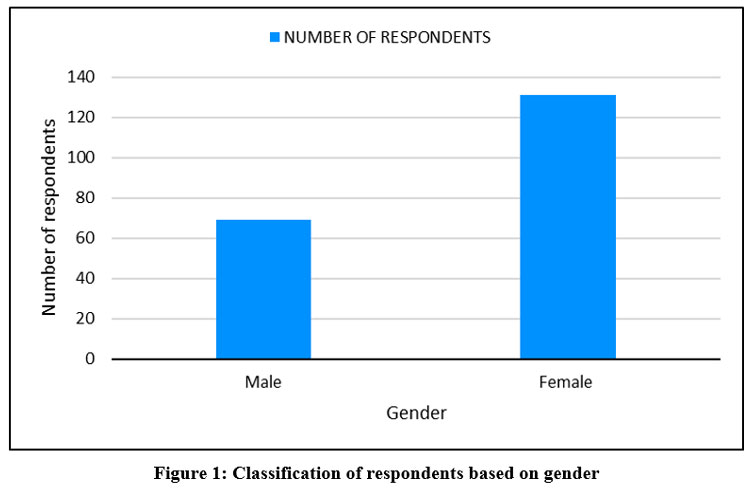 |
Figure 1: Classification of respondents based on gender Click here to view Figure |
Table 1 and Figure 1 represent the classification of the respondents based on their gender. The study comprises 69 (34.5%) male respondents and 131(65.5%) female respondents. The study's majority consisted of female respondents.
Table 2: Classification of Respondents based on Age.
|
Age |
Number of Respondents |
Percentage |
|
10-20 |
78 |
39 |
|
20-30 |
69 |
34.5 |
|
30-40 |
10 |
5 |
|
40-50 |
24 |
12 |
|
50-60 |
19 |
9.5 |
|
Total |
200 |
100 |
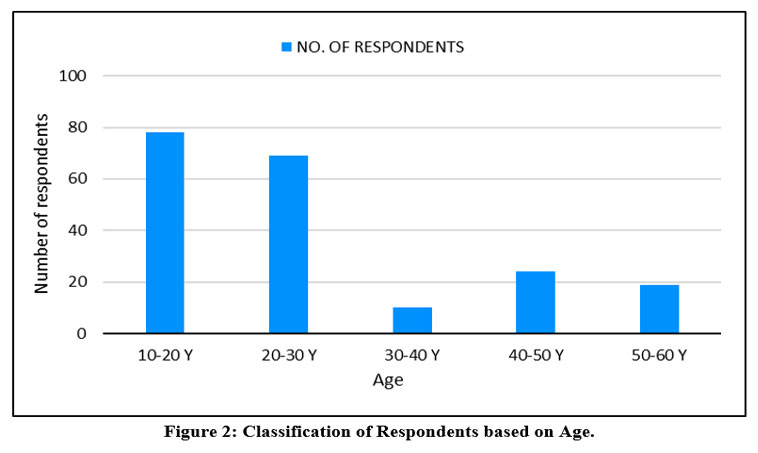 |
Figure 2: Classification of Respondents based on Age. Click here to view Figure |
The Table 2 and Graph 2 represent the classification of the respondents based on their ages.The study comprises 78 (39%) respondents of 10-20 years, 69(34.5%) respondents of 20-30 years,10 (5%) respondents of 30-40 years, 24(12%) respondents of 40-50 years, 19(9.5%) and respondents of 50-60 years. The study's majority consisted of respondents between the ages of 10- 20 years.
Table 3: Classification of Respondents Based on Familiarity with the Concept of Influencer Marketing
|
Preference |
Number of Respondents |
Percentage |
|
Familiar |
150 |
75 |
|
Not Familiar |
28 |
11 |
|
Neutral |
22 |
14 |
|
Total |
200 |
100 |
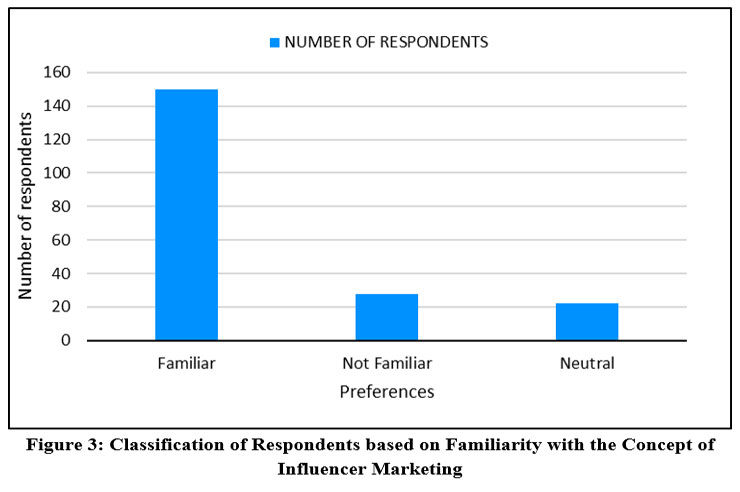 |
Figure 3: Classification of Respondents based on Familiarity with the Concept of Influencer Marketing Click here to view Figure |
The Table 3 and Figure 3 represent the classification of the respondents based on Familiarity with the concept of Influencer Marketing. The study comprises 150(75%) respondents who are familiar, 28(11%) respondents who are not familiar and the remaining 22(14%) respondents have neutral opinions on the concept of Influencer Marketing. The study's majority consisted of respondents to be familiar with the concept of Influencer Marketing.
Table 4: Classification of Respondents based on the Buying Behaviour Influenced by Others.
|
Preference |
Number of Respondents |
Percentage |
|
Preferred |
134 |
67 |
|
Not Preferred |
36 |
18 |
|
Neutral |
30 |
15 |
|
Total |
200 |
100 |
 |
Figure 4: Classification of Respondents based on the Buying Behaviour Influenced by Others. Click here to view Figure |
The Table 4 and Figure 4 represent the classification of the respondents based on Buying Behaviour influenced by others. The study comprises 134(67%) respondents prefer, 36(18%) respondents do not prefer and the remaining 30(15%) respondents have neutral opinions on being influenced by others for their buying Behaviour. The study majority consisted of the respondents preferring to be influenced by Others for their buying Behaviour.
Table 5: Classification of Respondents based on the Buying Behaviour Influenced by Celebrity Endorsements.
|
Preference |
Number of Respondents |
Percentage |
|
Preferred |
60 |
30 |
|
Not Preferred |
112 |
56 |
|
Neutral |
28 |
14 |
|
Total |
200 |
100 |
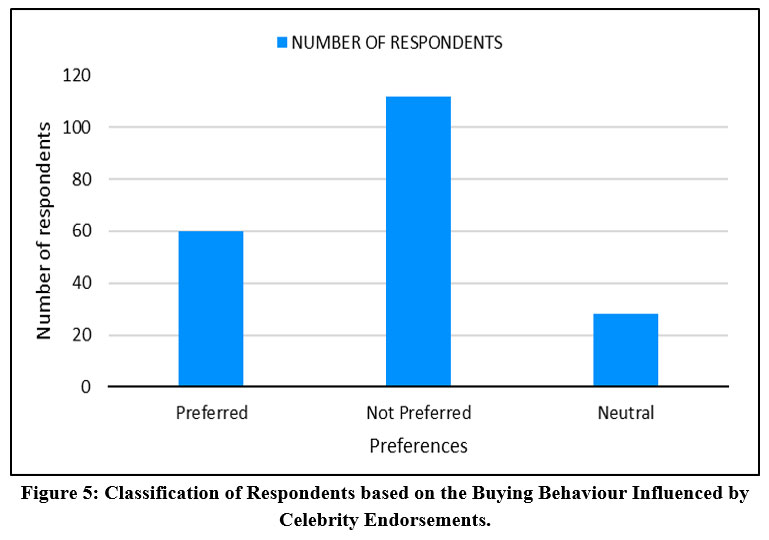 |
Figure 5: Classification of Respondents based on the Buying Behaviour Influenced by Celebrity Endorsements. Click here to view Figure |
The Table 5 and Figure 5 represent the classification of the respondents based on Buying Behaviour influenced by celebrity Endorsements. The study comprises 60 (30%) respondents prefer, 112(56%) respondents do not prefer and the remaining 28(14%) respondents have neutral opinions on being influenced by celebrity Endorsements for their buying Behaviour. The study majority consisted of the respondents not preferring to be influenced by celebrity Endorsements for their buying Behaviour.
Table 6: Classification of Respondents on Consumer buying behaviour based on Influencer Marketing.
|
Preference |
Number of Respondents |
Percentage |
|
Preferable |
166 |
83 |
|
Not Preferable |
5 |
2.5 |
|
Neutral |
29 |
14.5 |
|
Total |
200 |
100 |
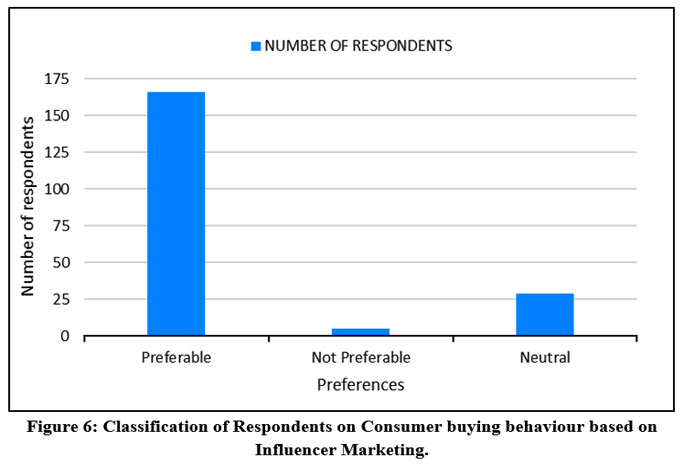 |
Figure 6: Classification of Respondents on Consumer buying behaviour based on Influencer Marketing. Click here to view Figure |
The Table 6 and Figure 6 represent the opinions of Respondents on Consumer buying behaviour based on Influencer Marketing. The study comprises 166 (83%) respondents who prefer, 5(2.5%) respondents who do not prefer, and the remaining 29 (14.5%) respondents who have neutral opinions on the effects of Influencer marketing on consumer buying behaviour. The study's majority consisted of respondents who prefer Influencer marketing as affecting consumer buying behaviour.
Table 7: Classification of respondents about influencer marketing’s role in positive environmental and social change.
|
Preferences |
Number of Respondents |
Percentage (%) |
|
Positive |
133 |
66.5 |
|
Negative |
14 |
7 |
|
Neutral |
53 |
26.5 |
|
Total |
200 |
100 |
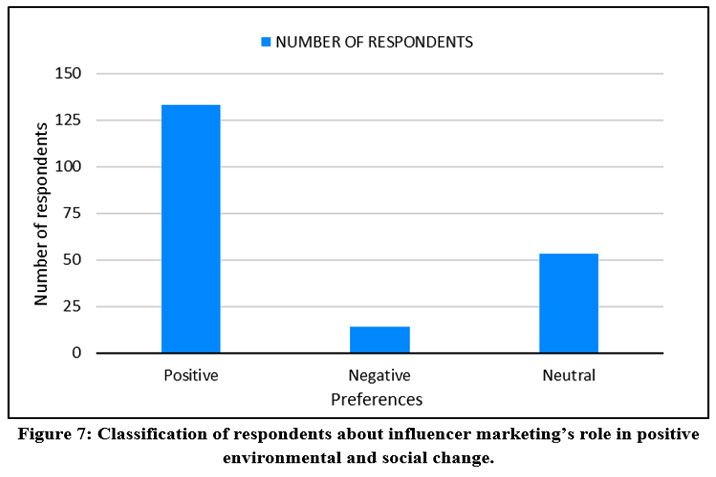 |
Figure 7: Classification of respondents about influencer marketing’s role in positive environmental and social change. Click here to view Figure |
The Table 7 and Figure 7 represent the influencer marketing’s role in positive environmental and social change
The study comprises 133(66.5%) respondents have positive, 14(7%) respondents have negative, and the remaining 53 (26.5%) respondents have neutral opinions about influencer marketing’s role in positive environmental and social change. The study majority consisted of the respondents having a positive impact on influencer marketing’s role in positive environmental and social change
Table 8: Classification of respondents based on preferences for sustainable lifestyles and consumer behaviour.
|
Preferences |
Number of Respondents |
Percentage (%) |
|
Preferred |
175 |
87.5 |
|
Not Preferred |
4 |
2 |
|
Neutral |
21 |
10.5 |
|
Total |
200 |
100 |
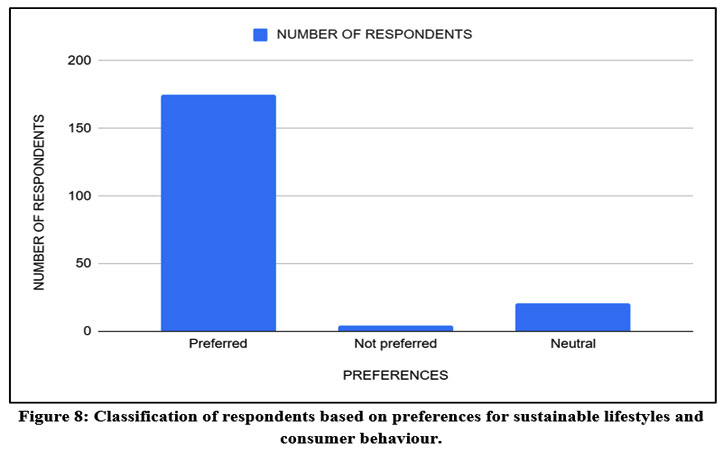 |
Figure 8: Classification of respondents based on preferences for sustainable lifestyles and consumer behaviour. Click here to view Figure |
The Table 8 and Figure 8 represent the classification of respondents based on preferences for sustainable lifestyles and consumer behaviour. The study comprises 175(87.5%) respondents who prefer, 4(2%) respondents who do not prefer, and the remaining 21 (10.5%) respondents who have neutral opinions on preferences for sustainable lifestyles and consumer behaviour. The study's majority consisted of the respondents preferring sustainable lifestyles and consumer behaviour.
Table 9: Opinions of respondents based on the negative post-purchase experience of the customer.
|
Preferences |
Number of Respondents |
Percentage (%) |
|
Negative |
98 |
49 |
|
Positive |
71 |
35.5 |
|
Neutral |
31 |
15.5 |
|
Total |
200 |
100 |
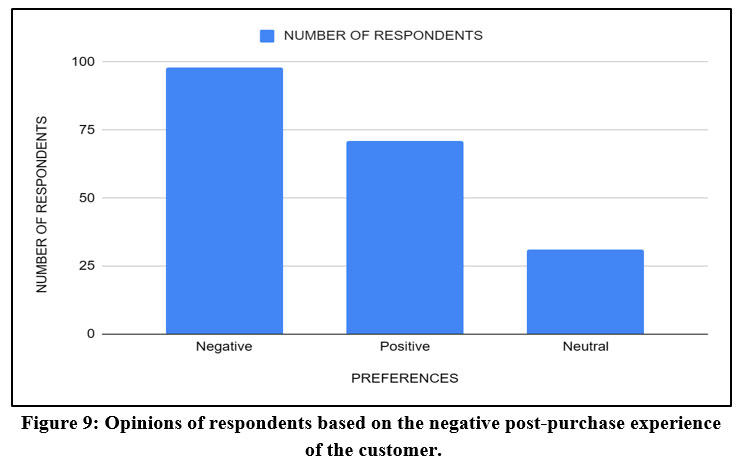 |
Figure 9: Opinions of respondents based on the negative post-purchase experience of the customer. Click here to view Figure |
The Table 9 and Figure 9 represent the opinions of respondents based on the negative post-purchase experience of the customer. The study comprises 98(49%) respondents who have a negative, 71(35.5%) respondents who have a positive, and the remaining 31(15.5%) respondents who have neutral opinions on regretting with regard to the post-purchase experience. The study's majority consisted of respondents having a negative impact and regretted their post-purchase experience.
Table 10: Opinion of respondents based on the influencer’s information reliability.
|
Preferences |
Number of Respondents |
Percentage (%) |
|
Preferred |
29 |
14.5 |
|
Not preferred |
88 |
44 |
|
Neutral |
83 |
41.5 |
|
Total |
200 |
100 |
 |
Figure 10: Opinion of respondents based on the influencer’s information reliability. Cl;ick here to view Figure |
The Table 10 and Figure 10 represent the opinions of respondents based on the influencer’s information reliability. The study comprises 29(14.5%) respondents who prefer, 88(44%) respondents who do not prefer and the remaining 83 (41.5%) respondents have neutral opinions on the influencer’s information reliability. The study majority consisted of the respondents not preferring having reliability on influencer’s information.
Table 11: Respondent’s opinion of influencer's impact on consumer awareness.
|
Preference |
Number of Respondents |
Percentage |
|
Accept |
85 |
42.5 |
|
Not Accept |
24 |
12 |
|
Neutral |
91 |
45.5 |
|
Total |
200 |
100 |
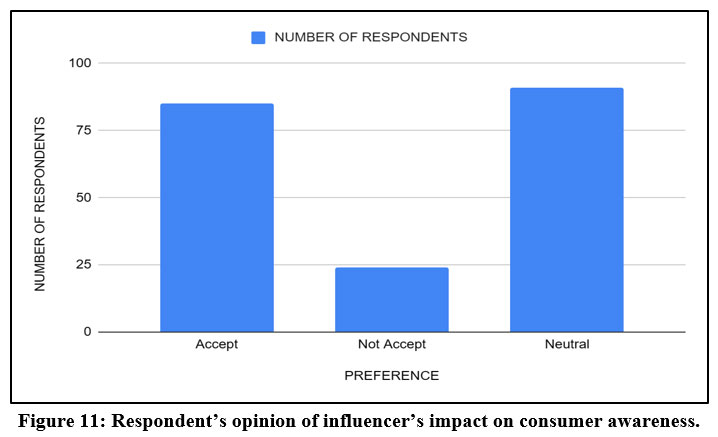 |
Figure 11: Respondent’s opinion of influencer’s impact on consumer awareness. |
The Table 11 and Figure 11 represent the respondents’ opinions of influencers' potential negative impact on consumer awareness. The study comprises 85(42.5%) respondents who accept, 24(12%) do not accept and the remaining 91(45.5%) respondents have neutral opinions on the concept of influencers' potential negative impact on consumer awareness. The study majority consisted of the respondents who had neutral opinions on the influencer's potential negative impact on consumer awareness.
Table 12: Classification of respondents based on the effectiveness of current influencers over traditional marketing.
|
Preferences |
Number of Respondents |
Percentage |
|
Effective |
100 |
50 |
|
Not Effective |
31 |
15.5 |
|
Neutral |
69 |
34.5 |
|
Total |
200 |
100 |
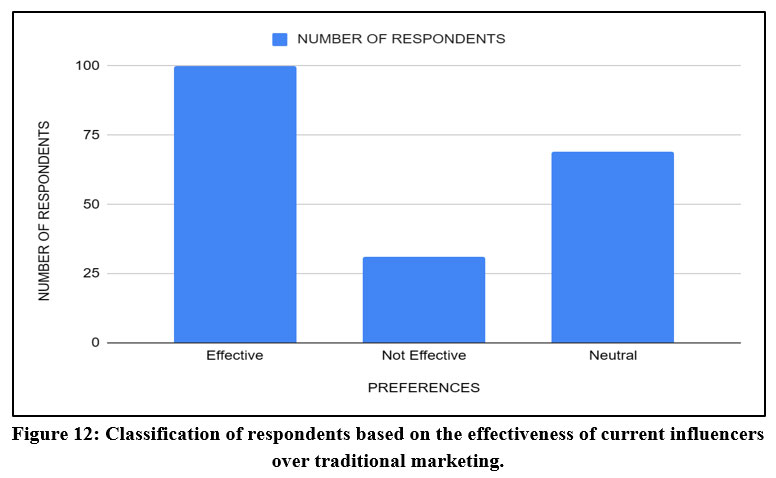 |
Figure 12: Classification of respondents based on the effectiveness of current influencers over traditional marketing. Click here to view Figure |
The Table 12 and Figure 12 represent the Classification of respondents based on the effectiveness of current influencers over traditional marketing. The study comprises 100(50%) respondents who assume it is effective, 31(15.5%) respondents who do not assume it is effective and the remaining 66 (34.5%) respondents have neutral opinions about the effectiveness of current influencers over traditional marketing. The study majority consisted of the respondents assuming that there is the effectiveness of current influencers over traditional marketing.
Table 13: Classification for repurchasing the product which is promoted by the influencers.
|
Preferences |
Number of Respondents |
Percentage |
|
Prefer |
39 |
19.5 |
|
Not Prefer |
101 |
50.5 |
|
Neutral |
60 |
30 |
|
Total |
200 |
100 |
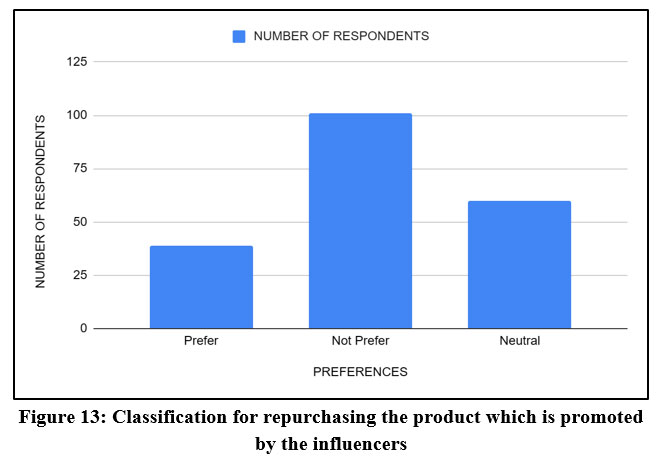 |
Figure 13: Classification for repurchasing the product which is promoted by the influencers Click here to view Figure |
The Table 13 and Figure 13 represent the opinion of respondents based on preferences for repurchasing the product which is promoted by the influencers. The study comprises 39 (19.5%) respondents who prefer, 101(50.5%) respondents who do not prefer, and the remaining 60 (30%) respondents who have neutral opinions on repurchasing a product that is promoted by influencers. The study's majority consisted of respondents who do not prefer to repurchase a product that is promoted by influencers.
Table 14: Opinion of respondents based on perception of influencers association with the brand.
|
Preferences |
Number of respondents |
Percentage (%) |
|
Influenced |
68 |
34 |
|
Not Influenced |
68 |
34 |
|
Neutral |
64 |
32 |
|
Total |
200 |
100 |
 |
Figure 14: Classification of respondents based on perception of influencers association with the brand. Click here to view Figure |
Table 14 and Figure 14 represent the opinions of respondents based on the perception of influencers association with the brand. The study comprises 68 (34%) respondents who are influenced, 68(34%) respondents who are not influenced, and the remaining 64 (32%) respondents who have a neutral perception of influencers association with the brand. The study majority consisted of the respondents being mostly either influenced or not influenced by the perception of influencers' association with a brand.
Findings
The primary data was collected from surveying to get an insight into the consumer's opinions.
The relevant graphs used for the findings are presented above under interpretation. It was shown through graphs and answers from the questionnaire that:
This report also consists of information collected from the years 2000-2023. The review discusses how different social media tools help convey the message to the customers about the company and also the customer knows detailed information about the company's products. (Mangold et al., 2009) In the olden days, the term “Social media influencer marketing” was known as celebrity endorsements (Masuda et al., 2022) which aimed to engage and associate the brand with the attitude and personality of a celebrity, which required the influencer to focus more on convincing the audience that they admire the brand (Silvera et al., 2004).
The influence that a known celebrity is using the product has a psychological impact on the buying considerations of a consumer (Silvera et al., 2004). Social media marketing can also affect a company's brand image and brand awareness (Bruno Godey et al., 2016).
It is important to gain the trust of the audience. The attitude and behaviour of the influencer play an important role. People tend to buy more when they perceive the influencer as reliable (Masuda et al., 2022). An influencer's credibility and perceived trustworthiness are the two primary features making this type of marketing and brand promotion effective. (Lin et al., 2019). To be able to promote the idea of the business the influencer needs to have a strong connection with the customers. The largest success is generated by users who have previously been influential and have a magnitude of followers (Eytan Bakshy et al., 2009). The celebrity type of the influencer and their agreement with the products and services and the interactions online influence the customers about the way they think about the brand. (Francisco J. et al., 2020). This gives the influencer the freedom to work according to their needs, it requires a great deal of originality when it comes to the posts that they create. The content posted online by is usually written or produced by themselves, hence making them authentic and reflecting their personality making it relatable to the audience (Leung et al., 2022). When freedom is given along with celebrity status it even leads to facing criticism. While sincere influencers are providing the correct information, there are insincere influencers who claim to have a huge following or inflated engagement with the audience. This makes the audience question their sincerity as discussed by (Belanche D. et al., 2019). Sustainability and marketing have much to offer each other. Research has proved that consumers react favorably to organizations that follow corporate social responsibility initiatives with which they create their image. (Sungchul Choi et al., 2011). With the aspect of sustainability in mind, it becomes important to ensure all people can satisfy their basic needs as well as enjoy a better, fuller, and more sustainable life without compromising the quality of life for future generations. (Jones P. et al., 2008).
Challenges And Ethical Implications
Greenwashing: Some influencers and brands may engage in greenwashing, where sustainability claims are exaggerated or falsely advertised to mislead consumers. This poses ethical challenges and the risk of undermining genuine sustainability efforts. The research paper by (Jones P. et al., 2008) highlights how According to the paper, marketers influence the audience to buy things that they do not want to buy. To the customer, in order to maintain a lifestyle such a buying consideration can lead to incurring huge debts. In such situations, influencers are viewed as manipulators who mislead the customers for profit.
Lack of Standardisation: The absence of standardized metrics for measuring the impact of influencer marketing on sustainability makes it challenging to assess its effectiveness accurately.
Lack of Trust: While sincere influencers provide the correct information, there are a few unethical influencers. These people claim to have fake numbers and followers or inflated rates of engagement to publicize themselves. The research paper by (Belanche D. et al., 2019) highlights how influencer marketing creates a lack of trust. According to the paper, insincere influencers claim to have a huge following or inflated engagement with the audience, and few are sincere. The influencer must maintain trust to show that they are genuine.
Gaining Trust: Building strong trust is an important challenge for influencer marketing. To gain trust the influencer should only be promoting the products which are highly recommended and products of High Quality. The research paper by (Lin R. et al., 2019) highlights the fact that the perception of the customer plays an important role in gaining trust. According to the paper, when a customer perceives that the products that the influencer is trying to promote are genuine, the customer tends to have a positive attitude and gets influenced by the products that are further recommended by the influencer.
Ethical Considerations
As influencer marketing gains momentum in advocating for sustainable lifestyles, ethical considerations become crucial. Transparent disclosures of partnerships, authenticity in content creation, and avoiding deceptive practices are essential in maintaining the trust between influencers and their followers.
Role Of Influencers In Increasing Consumer Awareness And Encouraging Positive Environmental And Social Change
Educating the Audience: The audience can be educated through influencers on various issues, clarifying doubts about the product and providing accurate information. This helps in creating and promoting awareness about the brand.
Fundraising: Influencers can influence the audience to support charitable causes, and relief funds and provide financial support during a crisis through influencer marketing.
Perception: By using social media platforms, influencers can bring positive thinking and behaviour change to the audience to adopt sustainable practices.
Conclusion
In conclusion, this research paper examined the effectiveness of influencer marketing in promoting sustainable lifestyles and consumer behaviour. An examination of existing literature and empirical evidence reveals that influencers have the potential to influence positive change in society’s attitudes toward sustainability. Influencer marketing has proven multiple times to be an effective instrument for promoting sustainable lifestyles and positively influencing consumer behaviour.
Influencers still remain to be one of the most effective tools in promotion. They can highly impact in increasing brand awareness ie, brand recognition and recall. Even for the purpose of promoting sustainability, they have a significant role. This can be attained by the complete commitment from both the audience and the influencers. A previous paper stated “The second result was that influencer credibility positively influences attitude toward the Instagram post. Subsequently, attitude toward the Instagram post has a positive impact on attitude toward the promoted brand”. (Lin R. et al., 2019). The primary research also found that people believed influencer marketing had a positive impact on consumer awareness.
But it is also understood that people do not completely rely on the information given by the influencers. Their trustworthiness is questioned. At times we see that what these influencers promote may not have a strong background and justification. Their opinions too may be manipulated and hence why people do not have complete confidence. The study also found that consumers don't always believe what they see. It was also stated that “words, brands bear the brunt of consumers' anger, whereas influencers experience a certain amount of reprieve. Thus, brand managers should be careful while partnering with influencers and employing them to endorse their products.” (Pradhan D. et al., 2019).
We can make significant strides towards creating a more eco-conscious and responsible consumer society by leveraging the reach and influence of social media influencers for sustainable initiatives. As the social media and sustainability landscape evolves, ongoing research and strategy adaptation will be required to maximize the effectiveness of influencer marketing in promoting a sustainable future.
Acknowledgment
The authors would like to thank the Centre for Management Studies Jain (Deemed-to-be) University for their support of research work.
We are deeply thankful to Dr. Pallavi D R for her invaluable guidance, support, and mentorship throughout the course of this research. We extend our appreciation to our peers and interviewees who provided valuable insights and constructive responses during the various stages of this research.
Conflict Of Interest
No conflict of interest.
Funding Source
There is no funding sources
References
- Belanche, D., Casaló, L. V., Flavián, M., & Ibáñez-Sánchez, S. (2021). “Understanding influencer marketing: The role of congruence between influencers, products and consumers.” Journal of Business Research, 132, 186–195.
CrossRef - Bruno Godey., Aikaterini Manthiou., Daniele Pederzoli., Joonas Rokka., Gaetano Aiello., Raffaele Donvito., Rahul Singh. (2016). “Social media marketing efforts of luxury brands: Influence on brand equity and consumer behaviour.”
CrossRef - Cartwright, S., Liu, H., & Davies, I. A. (2022). “Influencer marketing within business-to-business organizations.” Industrial Marketing Management, 106, 338–350.
CrossRef - Eytan Bakshy., Jake M. Hofman., Winter A. Mason., Duncan J. Watts. (2009). “Everyone’s an Influencer: Quantifying Influence on Twitter.”
- Francisco J. Martínez-López., Rafael Anaya-Sánchez., Marisel Fernández Giordano & David Lopez. (2020). “Behind influencer marketing: key marketing decisions and their effects on followers’ responses.”
CrossRef - Glucksman, M. (2017). “The rise of social media influencer marketing on lifestyle branding: A case study of Lucie Fink.” Elon Journal of undergraduate research in communications, 8(2), 77-87.
- Jones, P., Clarke?Hill, C., Comfort, D., & Hillier, D. (2008). “Marketing and sustainability.” Marketing intelligence & planning, 26(2), 123-130.
CrossRef - Leung, F. F., Gu, F. F., Li, Y., Zhang, J. Z., & Palmatier, R. W. (2022). “Influencer marketing effectiveness.” Journal of Marketing, 86(6), 93–115.
CrossRef - Lin, R., Jan, C., & Chuang, C. (2019). “Influencer Marketing on Instagram.” International Journal of Innovation in Management, Vol. 7, No. 1.
- Mangold, W. G., & Faulds, D. J. (2009). “Social media: The new hybrid element of the promotion mix.” Business Horizons, 52(4), 357-365.
CrossRef - Masuda, H., Han, S. H., & Lee, J. (2022). “Impacts of influencer attributes on purchase intentions in social media influencer marketing: Mediating roles of characterizations.” Technological Forecasting and Social Change.
CrossRef - Pradhan, D., Kuanr, A., Pahi, S. A., & Akram, M. S. (2022). “Influencer marketing: When and why Gen Z consumers avoid influencers and endorsed brands.” Psychology & Marketing - Wiley.
CrossRef - Silvera, D. H., & Austad, B. (2004). “Factors predicting the effectiveness of celebrity endorsement advertisements.” European Journal of Marketing, 38(11/12), 1509-1526.
CrossRef - Sungchul Choi., Alex Ng. (2011). “Environmental and Economic Dimensions of Sustainability and Price Effects on Consumer Responses.”
- Joshi, Y., Lim, W. M., Jagani, K., et al. (2023). “Social media influencer marketing: foundations, trends, and ways forward.” Electronic Commerce Research
CrossRef - Audrezet, A., & Koles, B. (2023). “Virtual Influencer as a Brand Avatar in Interactive Marketing.” In C.L. Wang (Ed.), The Palgrave Handbook of Interactive Marketing. Palgrave Macmillan.
CrossRef

This work is licensed under a Creative Commons Attribution 4.0 International License.






